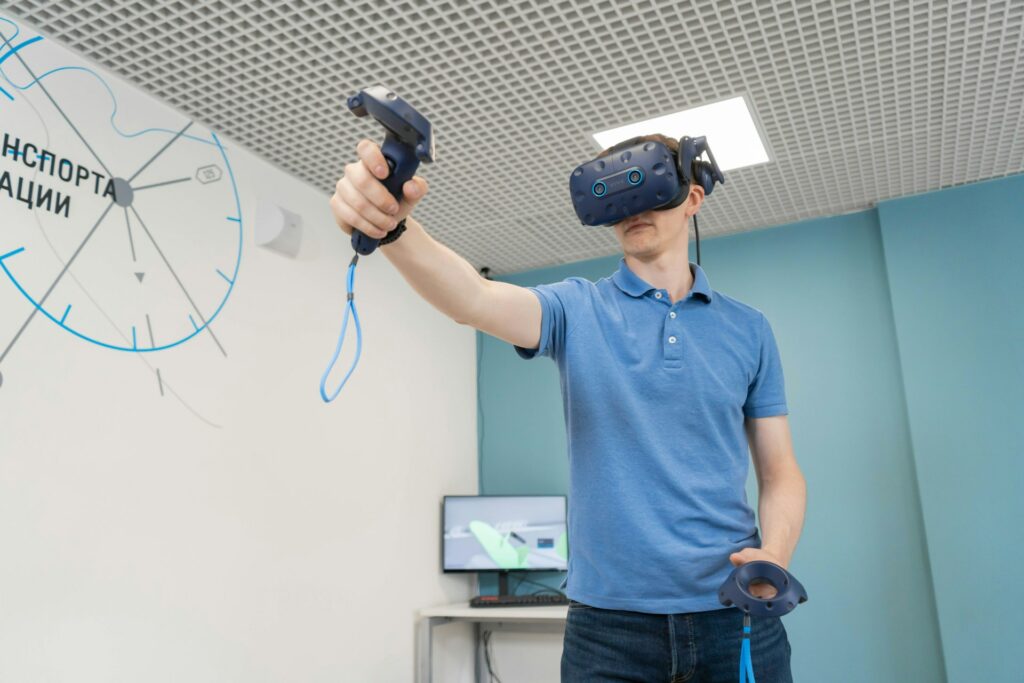The Use of Virtual Reality in the Training of Medical and Engineering Professionals

The Use of Virtual Reality in the Training of Medical and Engineering Professionals
The Importance of Virtual Reality in Professional Training
Virtual reality (VR) has expanded beyond the realm of gaming and entertainment and is now being used in a variety of industries. In recent years, it has become a very useful tool in professional education, particularly in engineering and medicine. Virtual reality (VR) is a technology that allows learners to practice complicated abilities in a safe and effective manner prior to applying them in real-world circumstances by delivering immersive, interactive, and realistic settings.
Environments that are conducive to immersive learning
Immersion is one of the most significant advantages of virtual reality (VR). Virtual reality (VR) is different from conventional textbooks or even computer screen simulations in that it immerses students in a three-dimensional world. In this environment, students may interact with tools, models, and situations as if they were genuine. This immersive quality results in improved concentration, more engagement, and increased retention of information.
Virtual reality in medical training: a safer method of learning
Virtual reality offers a safe environment for students and experts in the medical field to practice operations without jeopardizing the safety of patients. Surgeons are able to go through the steps of surgeries in advance, medical students are able to investigate human anatomy in three dimensions, and nurses are able to get training in emergency situations. Virtual reality is an excellent platform for experimentation, learning from mistakes, and improvement since errors made in virtual reality do not have any real-world implications.
Practicing Surgery in the Absence of Risk
Surgical simulation is one of the most significant applications of virtual reality in the medical field. Those who are participating in training have the ability to practice incisions, follow surgical procedures, and wield virtual tools in a setting that is quite realistic. Students are able to build accuracy and confidence before entering the operating room as a result of this, which also decreases the dependency on cadavers and the number of chances for practice in actual situations.
Making Improvements to Education in Anatomy and Physiology
Virtual reality technology makes the study of anatomy far more engaging and realistic than traditional methods, which generally use on diagrams or cadaver studies. Through the use of interactive tools, students have the ability to investigate organs, tissues, and systems, as well as zoom in on or rotate structures in order to get a more in-depth knowledge. This results in a dynamic learning process that exceeds the approaches of passive study.
Virtual reality in engineering training: constructing without limitations
Virtual reality (VR) technology enables students and experts in the field of engineering to build, test, and interact with structures before they are physically created. Virtual reality (VR) enables anyone to experiment with prototypes in a manner that is both inexpensive and risk-free, ranging from bridges to complicated equipment.
Simulations of Structures and Designs
Engineers are able to envision projects in three dimensions, test stress points, and replicate real-world circumstances like as wind, load, or heat thanks to virtual reality (VR) technology. This makes it possible to get feedback on design faults right away and to make improvements far in advance of the start of construction or production.
Training for Environments That are Dangerous
Working in the engineering field sometimes entails being present in areas that are considered to be high-risk, such as building sites, power plants, or oil rigs. Engineers have the opportunity to acquire safety regulations, equipment handling, and problem-solving skills in a safe training simulation environment created by virtual reality (VR), which eliminates the risk of exposure to danger. This not only raises safety awareness, but it also helps to minimize the number of incidents that occur in the workplace.
Training Solutions That Are Economically Viable
The cost of higher education in both medicine and engineering may be prohibitively high, as it includes expenses connected with equipment, facilities, and live training sessions. Virtual reality is a more affordable option since a single system is capable of simulating an infinite number of processes, settings, and situations without the requirement for actual resources.
Improving Collaboration and Teamwork
When it comes to medical and technical difficulties, it is critical to operate as a team. Virtual reality (VR) makes it possible for several people to engage with one another inside the same virtual world, independent of their physical location. This encourages communication skills, multidisciplinary training, and the ability to work together to solve problems.
Lowering Stress During High-Stakes Training
In situations that involve high amounts of pressure, such as emergency surgery or crisis engineering, it is essential to make decisions in a calm manner. Learners are exposed to realistic, stressful scenarios in virtual reality (VR), and in these situations, they are required to react swiftly and accurately. Trainees are able to improve their readiness for high-stakes situations in the actual world via the repetition of these scenarios.
The Difficulties and Constraints of Using Virtual Reality (VR) in Training
Even while there are advantages to virtual reality (VR), there are also problems that it must overcome. Some of the most often encountered obstacles are high development costs, the need for specialized gear, and the possibility of motion sickness. In addition, virtual reality training should be used to supplement, not replace, practical experience in the actual world. For training to be successful, it is also essential to make sure that simulations are both accurate and reliable.
The Role of Virtual Reality in Professional Education in the Future
With the continued development of technology, virtual reality (VR) will become more accessible, more inexpensive, and more lifelike. Adaptive learning environments, which are able to modify the level of difficulty depending on how well the students are doing, will become possible via integration with artificial intelligence. The addition of haptic feedback devices will provide users with a sensation of touch, making medical and technical instruction much more realistic than it is now.
The training of medical and technical professions is undergoing a change as a result of virtual reality technology. Virtual reality (VR) is able to bridge the gap between theory and practice by combining immersive experiences with risk-free practice. There is no question that it has played a significant influence in the development of training techniques that are safer, more effective, and more inventive, despite the fact that obstacles persist. As the technology involved in virtual reality continues to advance, it is expected to develop into an essential component of professional education on a global scale.




